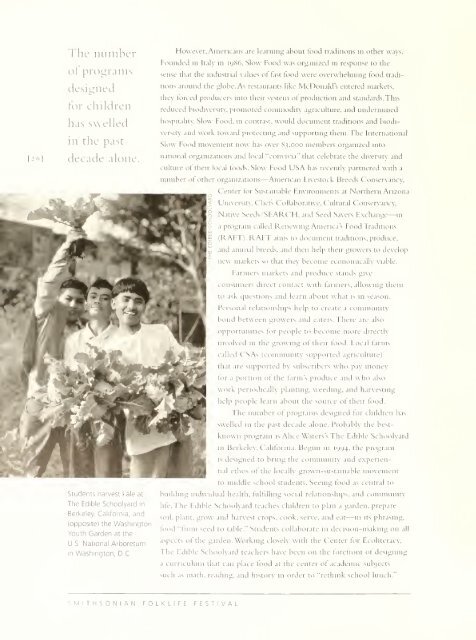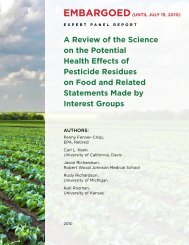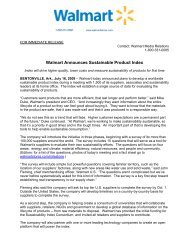"IThe numberof programsdesignedfor childrenhas swelledin the pastdecade alone.However, Americans are learning about food traditions in other ways.Founded in Italy in [986, Slow Food was organized in response to thesense that the industrial values of tasttood were overwhelming food traditionsaround the globe. As restaurants like McDonald's entered markets,they torced producers into their system of production and standards. Thisreduced biodiversity, promoted commodity agriculture, and underminedhospitality. Slow Food, in contrast, would document traditions and biodiversityand work toward protecting and supporting them. The InternationalSlow Food movement now has over 83,000 members organized intonational organizations and local "convivía" that celebrate the diversity andculture of their local foods. Slow Food USA has recently partnered with anumber ot other organizations—American Livestock Breeds Conservancy,Center tor Sustainable Environments at NorthernoArizona• University, Chefs Collaborative, Cultural Conservancy,INative Seeds/SEARCH, and Seed Savers Exchange— inaprogram called Renewing America's Food Traditionsew(RAFT). RAFT aims to document traditions, produce.and animal breeds, and then help their growers to developnew markets so that they become economically viable.Farmers markets and produce stands giveconsumers direct contact with tanners, allowing themto ask questions and learn about what is in season.Personal relationships help to create acommunitybond between growers and eatersThere are alsoopportunities tor people to become more directl)invoked 111the growing ot their tood. Local farmscalled CSAs (community supported agriculture)that are supported by subscribers who pay moneytor .1portion ot the farm's produce and who alsowork periodically planting, weeding, and harvestinghelp people learn about the source ot their tood.rhe number ot programs designed tor children hasswelled inthe past decade alone. Probably the bestknownprogram is Alice Waters's The Edible Schoolyard111 Berkeley, California. Begun 111 1994. the programisdesigned to bring the community and experientialethos of the locally grown-sustainable movementto middle school students. Seeing tood ascentral toStudents harvest kale atbuilding individual health, fulfilling socialrelationships, and communityThe Edible Schoolyard inBerkeley, California, and(opposite) the WashingtonYouth Garden at theU.S. National Arboretumin Washington, DC.lite, The Edible Schoolyard teaches children to plan a garden, preparesoil, plant, grow and harvest crops, cook, serve, and eat— in its phrasing,food "from seed to table.'' Students collaborate in decision-making on allaspects ot the garden. Working closely with the Center for Ecoliteracy,The Edible Schoolyard teachers have been on the forefront ot designinga curriculum that can place food at the center ot academic subjectssuch as math, reading, and history in order to "rethink school lunch."SMITHSONIAN FOLKLIFE FESTIVAL
a27Similarly, the Culinary Vegetable Institutein Huron, Ohio, has launched Veggie U toeducate food professionals and the generalpublic about vegetable growing and cooking.Recently, it has developed a curriculum forschools that will soon be m Texas systems.The Center for Ecoliteracy has developed adetailed "how-to" guide for school systemsto follow in creating their own programs.Spoons Across America, sponsored by theAmerican Institute of Food and Wine andthe |ames Beard Foundation, sponsors DaysofTaste in schools across the country. Localprograms also abound. In Washington, D.C.,Brainfood teaches children about life skillsthrough food activities after school and duringthe summer. The Washington Youth Gardengives children from the Washington, D.C.,public schools hands-on experience gardeningand then cooking their harvest. Programslike these are growing across the country.Then, of course, there is the timehonoredway of passing traditions on in familykitchens and on family farms. Hopefully, manyof these more formal programs remind cooksand growers to explore their own family traditionsand the foodways of those around them.This food revolution is about growing andcooking traditions and their adaptation to newcircumstances. It is about finding—amid a landscapedominated by pre-packaged goods—closer association with processes such as soilpreparation, harvesting, and cooking thatprevious generations took for granted. And itan awareness oí what a meal is, and how mealtimeis a time to slow down, to listen, and tosavor food. Perhaps most importantly, it is aboutsharing these things—or passing them on.This sharing and understanding taketime that today's busy schedules frequentlydon't allow. However, many are realizingthat the richness of shared experiencesinvolving food is too precious to give up.Thev think about the taste of afresh carrotpulled from a garden on a summer atternoonor a meal savored with family and friends.The food revolution that we celebratelooks both backward and forward: backwardto long-held community traditions ingrowing, marketing, cooking, and eating;forward to innovations for making thesetraditions sustainable and passing them on tofuture generations. It depends on nurturinga physical environment that supports diversity;sustaining the know ledge needed tocultivate that biodiversity; and passing ontraditions of preparing and eating. Together,these traditions are the foundation otmuch of our shared human experience.Everyone has to eat; why not cat together?isFOOD CULTURE USA
- Page 1: Smithsonianolklife Festival\Food Cu
- Page 4 and 5: The annual Smithsonian Folklite Fes
- Page 7 and 8: —CONTENTSThe Festival's Timely Ap
- Page 9 and 10: —THE FESTIVAL'S TIMELY APPEALLAWR
- Page 11 and 12: COMMERCE FOR CULTUREFrom the Festiv
- Page 13 and 14: [ii]The food concession for the Mel
- Page 15 and 16: oMiiitbioni.indotal SoundL04.A 1 Sl
- Page 17: 1WELCOME TO THE 2005 FOLKLIFE FESTI
- Page 20 and 21: Workers harvest artichokes at Ocean
- Page 22 and 23: —assigned aparticular dish—meat
- Page 24 and 25: I--IPot Pie Farm manager Elizabeth
- Page 26 and 27: ISustainable farmers such as Eliot
- Page 30 and 31: .hadSALAD GREENS WITH GOAT CHEESE,
- Page 32 and 33: w.A>wm:~
- Page 34 and 35: —3 3]OCCUPATIONAL CULTUREThe 2005
- Page 36 and 37: employees, the USDA Forest Servicei
- Page 38 and 39: I[3 6]page book, which could fit in
- Page 40 and 41: ká.!i- .>!mKPA backpacker sets up
- Page 42 and 43: --^i'liunterw eight jihI ...itl jib
- Page 44 and 45: —4-"The essentialpiece isto captu
- Page 46 and 47: I44cutDUTCH OVENONE-POT MEALThomas
- Page 48 and 49: —FUTURE CONCERNS FOR PUBLIC LANDS
- Page 50 and 51: NUESTRA MÚSICA: MUSIC INBuilding C
- Page 52 and 53: plena groups throughout the Northea
- Page 54 and 55: NUESTRA MÚSICA LAUNCHES NEW SERIES
- Page 56 and 57: NUESTRA MÚSICA: MUSIC IN LATINO CU
- Page 58 and 59: "ILos Camperos de Valles son músic
- Page 60 and 61: RAICES LATINASNUESTRA MÚSICA LANZA
- Page 63 and 64: IOMAN: DESERT, OASIS, AND SEARICHAR
- Page 65 and 66: DESERTThe deserts ot the Arabian Pe
- Page 67 and 68: THE FESTIVAL PROGRAMThe 200s Smiths
- Page 70 and 71: 6 8The coiled, leather-covered bask
- Page 72 and 73: 70]COASTAL CRAFTSMANSHIPAND GLOBAL
- Page 74 and 75: [72]Although the oldismaking way fo
- Page 76 and 77: AN OMANI FOLKTALEASYAH AL-BUALYOman
- Page 79 and 80:
y%aMUSIC AND DANCE INOMANOMAN CENTR
- Page 81:
In the southern Dhufar region, al-b
- Page 84 and 85:
ecosystems, identification of plant
- Page 86 and 87:
2:00IIIVorkshopFESTIVAL SCHEDULE (P
- Page 88 and 89:
Rhythm,Saturday, June 25 (Programs
- Page 90 and 91:
)avidi nestMonday, June 27(Programs
- Page 92 and 93:
1:00IIlamFriday, July 1 (Programs a
- Page 94 and 95:
)utchSunday, July 3(Programs are su
- Page 96 and 97:
EVENING CONCERTSSounds of the Fores
- Page 98 and 99:
theRELATED EVENTS[96]Nuestra Músic
- Page 100 and 101:
IIDónalas Anderson,Washington, D.C
- Page 102 and 103:
'IEd LiíDmi, Studio City, Californ
- Page 104 and 105:
ISudhir Seth, Bethesda, MarylandA g
- Page 106 and 107:
1 if 1 DumberHoneyBeehive Beeproduc
- Page 108 and 109:
1"''NewI >onI Lui\IDon Bustos,Espa
- Page 110 and 111:
Ian Barlow, White Bird,Idaho; Woodl
- Page 112 and 113:
I 'istnet1Gordon Grant,Corvallis, O
- Page 114 and 115:
Kristen Marline, Flagstaff,Arizona;
- Page 116 and 117:
I1 ountries,IIHistorie Site, once t
- Page 118 and 119:
1IworksI1 11Istations are vital to
- Page 120 and 121:
1'IenIpanderetas;JCJ Band. Washingt
- Page 122 and 123:
Ralph Rinzlersongs are "made" (or c
- Page 124 and 125:
I >cmseI VhorahII MiI lameEne Nance
- Page 126 and 127:
|i 2forIIBartlevy1 )oerr;IIParadeSP
- Page 128 and 129:
II AerialIIII1Washington and Jeffer
- Page 130 and 131:
Stack, Bill Stafford, loni Stafford
- Page 132 and 133:
SMITHSONIAN FOLKLIFE FESTIVAL 20051
- Page 135 and 136:
SMITHSONIAN FOLKLIFE FESTIVAL 2005B
- Page 138:
Smithsonian Folklife FestivalSMITHS








